2021 MERCEDES-BENZ GLB SUV wheel
[x] Cancel search: wheelPage 72 of 446
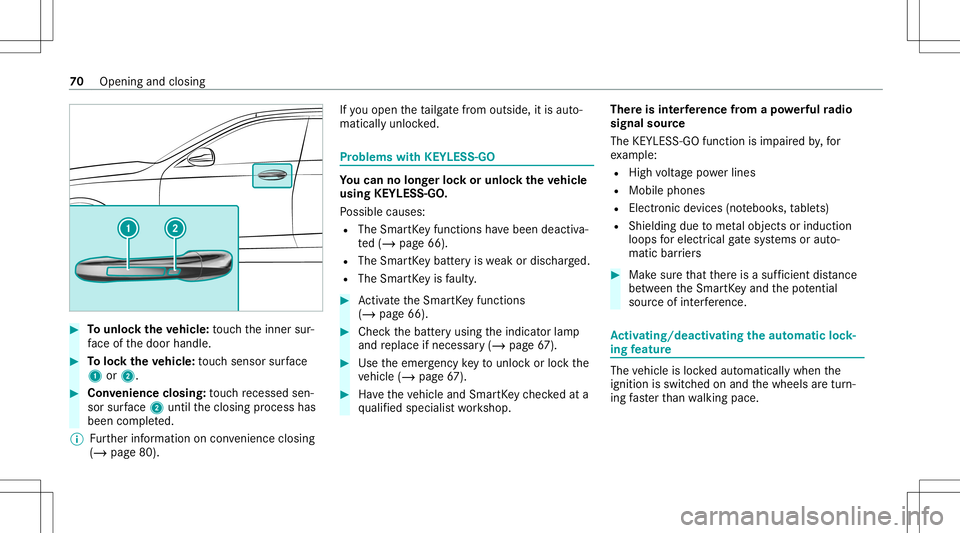
#
Tounlo cktheve hicl e:touc hth einner sur‐
fa ce ofthedoor handle. #
Toloc kth eve hicl e:touc hsen sor surface
1 or2. #
Convenience closing:touc hre cess edsen‐
sor surface 2untilth eclosing process has
been completed.
% Further information oncon venie nce closing
(/ page 80) . If
yo uopen theta ilg atefrom outs ide,itis aut o‐
matic allyunloc ked. Pr
oblems withKEYLE SS-GO Yo
ucan nolon gerlo ck orunloc kth eve hicl e
using KEYLESS-GO .
Po ssible causes:
R The Smar tKey functions have been deactiv a‐
te d(/ page66).
R The Smar tKey batt eryis we ak ordisc harged.
R The Smar tKey isfaulty . #
Activateth eSmar tKey functions
(/ page66). #
Che ckthebatt eryusing theindicat orlam p
and replace ifnec essar y(/ page67 ). #
Use theemer gency keyto unlo ckorloc kth e
ve hicle (/page67 ). #
Have theve hicle andSmar tKey checkedat a
qu alif ied spec ialistwo rkshop. Ther
eis int erfere nce from apo we rful radio
sig nal source
The KEYLESS-G Ofuncti onisim pa ired by,fo r
ex am ple:
R Highvo ltag epo we rlines
R Mobi lephones
R Electr onicdevices (notebook s,table ts)
R Shielding duetome talobje ctsor induc tion
loops forelectr icalgate systems oraut o‐
matic barrier s #
Mak esur eth at ther eis asuf ficie ntdist anc e
be tween theSmar tKey and thepo tentia l
sou rceof interfere nce. Ac
tiv atin g/deac tivatin gthe automati clo ck ‐
ing featur e The
vehicle isloc kedaut omatic allywhen the
ignit ionisswitc hedonand thewheels aretur n‐
ing faster than walkin gpace. 70
Openingand closing
Page 91 of 446
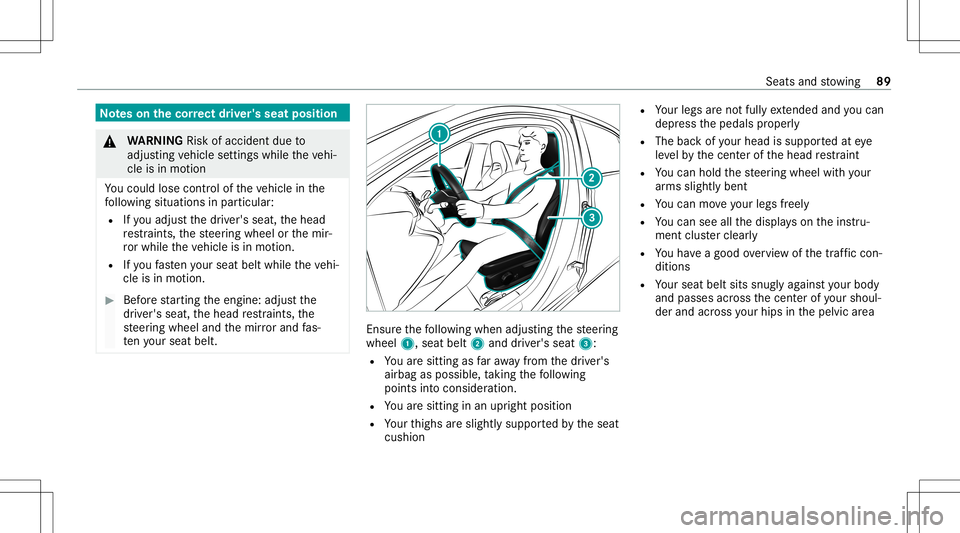
No
teson thecor rect driver' sseat position &
WARNIN GRisk ofacci dent dueto
adjus tingve hicle settin gswhile theve hi‐
cle isin mo tion
Yo uco uld lose contro lof theve hicle inthe
fo llo wing situat ionsinpar ticular :
R Ifyo uadj ustth edr iver's seat, thehead
re stra int s,thesteer ing wheel orthemir‐
ro rwhi letheve hicle isin mo tion.
R Ifyo ufa sten your seat beltwhile theve hi‐
cle isin mo tion. #
Beforest ar tin gth eengine: adjustth e
dr iver's seat, thehead restra int s,the
st eer ing wheel andthemir rorand fas‐
te nyo ur seat belt. En
sur eth efo llo wing when adjustingth esteer ing
wheel 1,seat belt2and driver's seat 3:
R Youar esit tin gas faraw ay from thedr iver's
airbag aspossible, taking thefo llo wing
point sint ocon sider ation .
R Youar esit tin gin an upr ight position
R Your thighs areslight lysuppor tedby theseat
cushion R
Your legs areno tfull yex tende dand youcan
depr essthepedals proper ly
R The backof your head issuppo rted ateye
le ve lby thecent erofthehead restra int
R Youcan hold thesteer ing wheel withyo ur
ar ms sligh tly ben t
R Youcan moveyour legs freel y
R Youcan seeallthedispla yson theins tru‐
ment clusterclea rly
R Youha ve agood overvie wof thetra ffic con ‐
dition s
R Your seat beltsitssn ug lyag ains tyo ur body
and pass esacr oss thecent erofyour sho ul‐
der and across your hips inthepelvic area Seats
andstow ing 89
Page 93 of 446
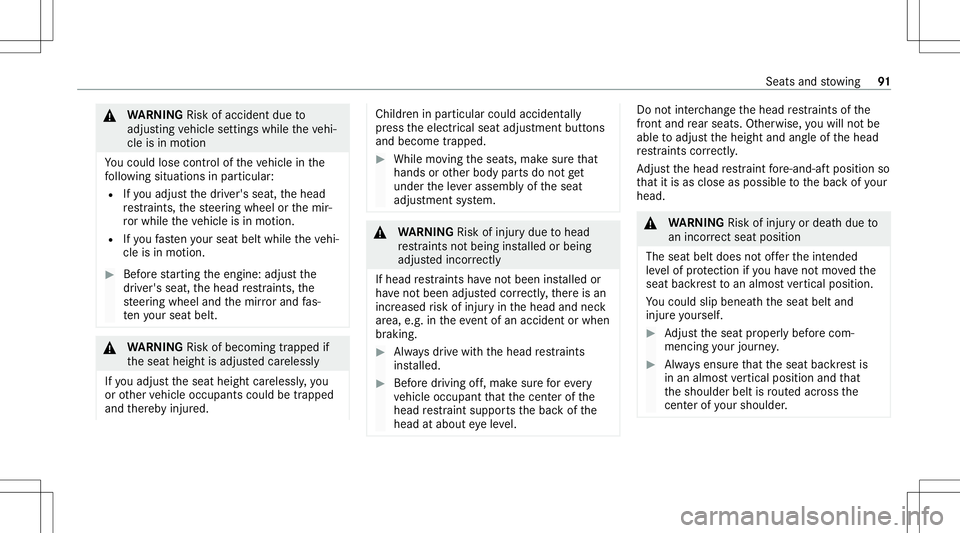
&
WARNIN GRisk ofacci dent dueto
adjus tingve hicle settin gswhile theve hi‐
cle isin mo tion
Yo uco uld lose contro lof theve hicle inthe
fo llo wing situat ionsinpar ticular :
R Ifyo uadj ustth edr iver's seat, thehead
re stra int s,thesteer ing wheel orthemir‐
ro rwhi letheve hicle isin mo tion.
R Ifyo ufa sten your seat beltwhile theve hi‐
cle isin mo tion. #
Beforest ar tin gth eengine: adjustth e
dr iver's seat, thehead restra int s,the
st eer ing wheel andthemir rorand fas‐
te nyo ur seat belt. &
WARNIN GRisk ofbeco ming trap ped if
th eseat height isadjus tedcar elessl y
If yo uadj ustth eseat height carelessly ,yo u
or other vehicle occupants couldbetrapped
and ther eb yinjur ed. Childr
eninpar ticular couldacciden tally
pr ess theelectr icalseat adjus tmentbutt ons
and become trapped. #
While moving theseats, makesur eth at
han dsorother body partsdo notget
und ertheleve rasse mbly oftheseat
adjus tmentsy stem. &
WARNIN GRisk ofinju rydue tohead
re stra int sno tbeing installed orbeing
adjus tedincor rectl y
If hea dre stra int sha ve notbe en installed or
ha ve notbe en adjus tedcor rectly ,th er eis an
incr eased risk ofinjur yin thehead andneck
ar ea, e.g. intheev ent ofan acciden tor when
br aking. #
Alw aysdr ive wit hth ehead restra int s
ins talled. #
Beforedr ivin gof f,mak esur efo rev ery
ve hicle occupant that thecent erofthe
head restra int suppor tsthebac kof the
head atabout eyeleve l. Do
notint erch ang eth ehead restra int sof the
fr ont and rear seat s.Ot her wise, youwill notbe
able toadjus tth eheight andangleof thehead
re stra int scor rectl y.
Ad jus tth ehead restra int fore -and -aftpo sitio nso
th at itis as clo seasposs ibletothebac kof your
head. &
WARNIN GRisk ofinju ryor deat hdue to
an incorrect sea tpos ition
The seatbel tdoe sno tof ferth eint ended
le ve lof protect ion ifyo uha ve notmo vedth e
seat backres tto an almos tve rtical posit ion.
Yo uco uld slip beneathth eseat beltand
injur eyo urself . #
Adjus tth eseat proper lybef orecom‐
menc ingyour jour ne y. #
Alw aysensur eth at theseat backres tis
in an almos tve rtical posit ionand that
th eshoulder beltisrouted acr oss the
cent erofyour sho ulder . Sea
tsand stow ing 91
Page 94 of 446
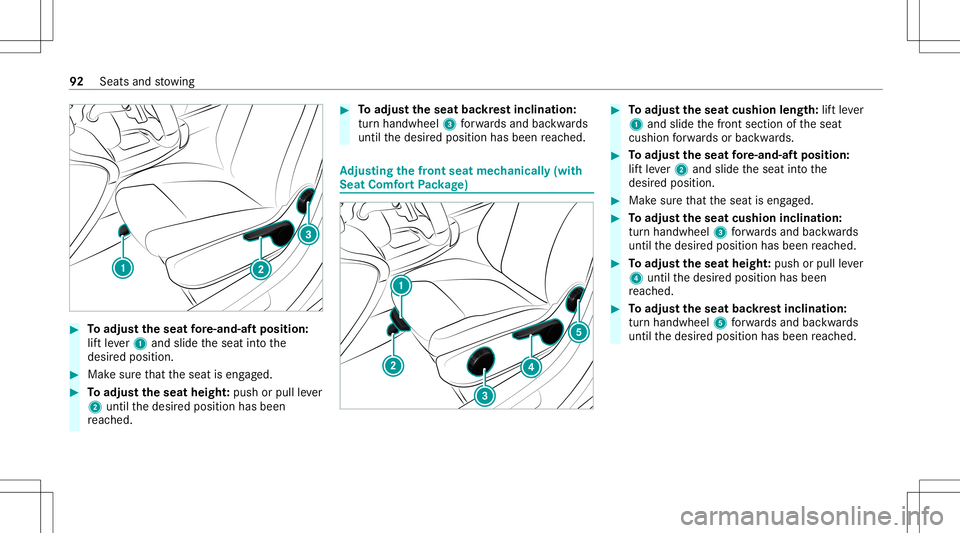
#
Toadjus tth eseat fore -and-af tposi tion:
lif tle ve r1 and slideth eseat intoth e
desir edposition . #
Mak esur eth at theseat iseng aged. #
Toadjus tth eseat heigh t:push orpull leve r
2 untilth edesir edposition hasbeen
re ac hed. #
Toadjus tth eseat backres tinclina tion:
tur nhand wheel 3forw ards and backwards
unt ilth edesir edposition hasbeen reac hed. Ad
jus tingthe fron tse at mec hanicall y(w ith
Se at Co mf ortPa ckag e) #
Toadjus tth eseat cushionlengt h:liftle ve r
1 and slide thefront sect ionoftheseat
cushion forw ards orbac kwards. #
Toadjus tth eseat fore -and-af tposi tion:
lif tle ve r2 and slideth eseat intoth e
desir edposition . #
Mak esur eth at theseat iseng aged. #
Toadjus tth eseat cushioninclina tion:
tur nhand wheel 3forw ards and backwards
unt ilth edesir edposition hasbeen reac hed. #
Toadjus tth eseat heigh t:push orpull leve r
4 untilth edesir edposition hasbeen
re ac hed. #
Toadjus tth eseat backres tinclina tion:
tur nhand wheel 5forw ards and backwards
unt ilth edesir edposition hasbeen reac hed. 92
Seatsand stow ing
Page 99 of 446
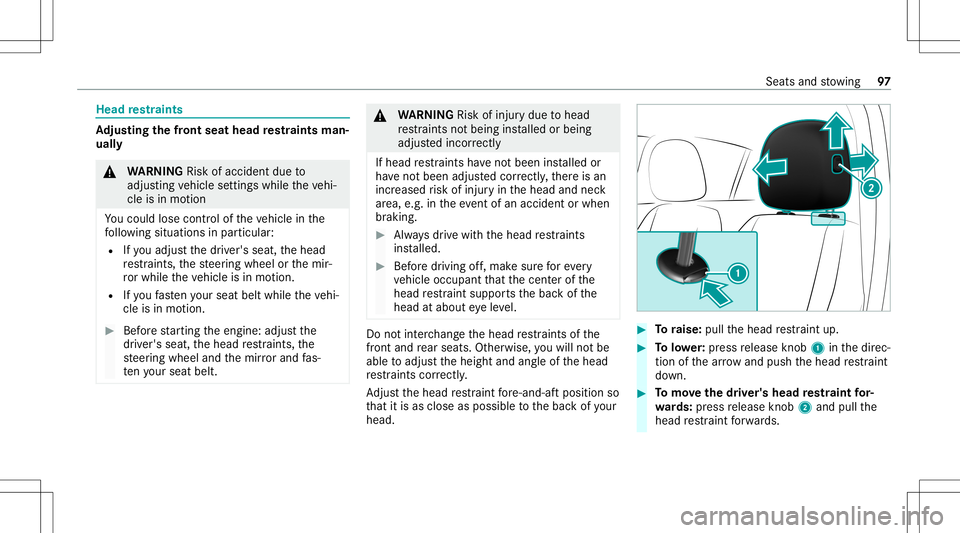
Head
restra ints Ad
jus tingthe fron tse at head restra ints man‐
uall y &
WARNIN GRisk ofacci dent dueto
adjus tingve hicle settin gswhile theve hi‐
cle isin mo tion
Yo uco uld lose contro lof theve hicle inthe
fo llo wing situat ionsinpar ticular :
R Ifyo uadj ustth edr iver's seat, thehead
re stra int s,thesteer ing wheel orthemir‐
ro rwhi letheve hicle isin mo tion.
R Ifyo ufa sten your seat beltwhile theve hi‐
cle isin mo tion. #
Beforest ar tin gth eengine: adjustth e
dr iver's seat, thehead restra int s,the
st eer ing wheel andthemir rorand fas‐
te nyo ur seat belt. &
WARNIN GRisk ofinju rydue tohead
re stra int sno tbeing installed orbeing
adjus tedincor rectl y
If hea dre stra int sha ve notbe en installed or
ha ve notbe en adjus tedcor rectly ,th er eis an
incr eased risk ofinjur yin thehead andneck
ar ea, e.g. intheev ent ofan acciden tor when
br aking. #
Alw aysdr ive wit hth ehead restra int s
ins talled. #
Beforedr ivin gof f,mak esur efo rev ery
ve hicle occupant that thecent erofthe
head restra int suppor tsthebac kof the
head atabout eyeleve l. Do
notint erch ang eth ehead restra int sof the
fr ont and rear seat s.Ot her wise, youwill notbe
able toadjus tth eheight andangleof thehead
re stra int scor rectl y.
Ad jus tth ehead restra int fore -and -aftpo sitio nso
th at itis as clo seasposs ibletothebac kof your
head. #
Toraise: pullthehead restra int up. #
Tolowe r:press release knob 1 inthedir ec‐
tion ofthear row and push thehead restra int
do wn. #
Tomo vethedr iver' shead restra int for‐
wa rds: press release knob 2 and pullthe
head restra int forw ards. Seat
sand stow ing 97
Page 103 of 446
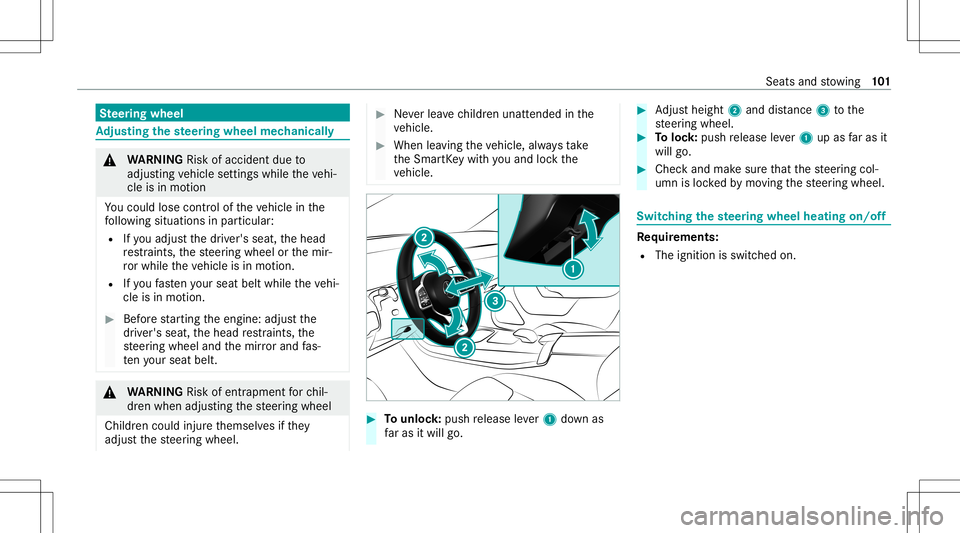
Ste
ering wheel Ad
jus tingthe steer ing wheel mechanicall y &
WARNIN GRisk ofacci dent dueto
adjus tingve hicle settin gswhile theve hi‐
cle isin mo tion
Yo uco uld lose contro lof theve hicle inthe
fo llo wing situat ionsinpar ticular :
R Ifyo uadj ustth edr iver's seat, thehead
re stra int s,thesteer ing wheel orthemir‐
ro rwhi letheve hicle isin mo tion.
R Ifyo ufa sten your seat beltwhile theve hi‐
cle isin mo tion. #
Beforest ar tin gth eengine: adjustth e
dr iver's seat, thehead restra int s,the
st eer ing wheel andthemir rorand fas‐
te nyo ur seat belt. &
WARNIN GRisk ofentr apment forch il‐
dr en when adjustingth esteer ing wheel
Childr encould injureth emselv esifth ey
adjus tth esteer ing wheel. #
Neverlea vechildr enunat tende din the
ve hicle. #
When leaving theve hicle, alwaysta ke
th eSmar tKey wit hyo uand lockth e
ve hicle. #
Tounlo ck:pu sh release leve r1 down as
fa ras itwil lgo. #
Adjus the ight 2 and dist anc e3 tothe
st eer ing wheel. #
Toloc k:push release leve r1 upasfaras it
wil lgo. #
Chec kand makesur eth at thesteer ing col‐
umn isloc kedby mo ving thesteer ing wheel. Switc
hingthest eer ing wheel heatingon/of f Re
quirement s:
R The ignit ionisswitc hedon. Seat
sand stow ing 10
1
Page 104 of 446
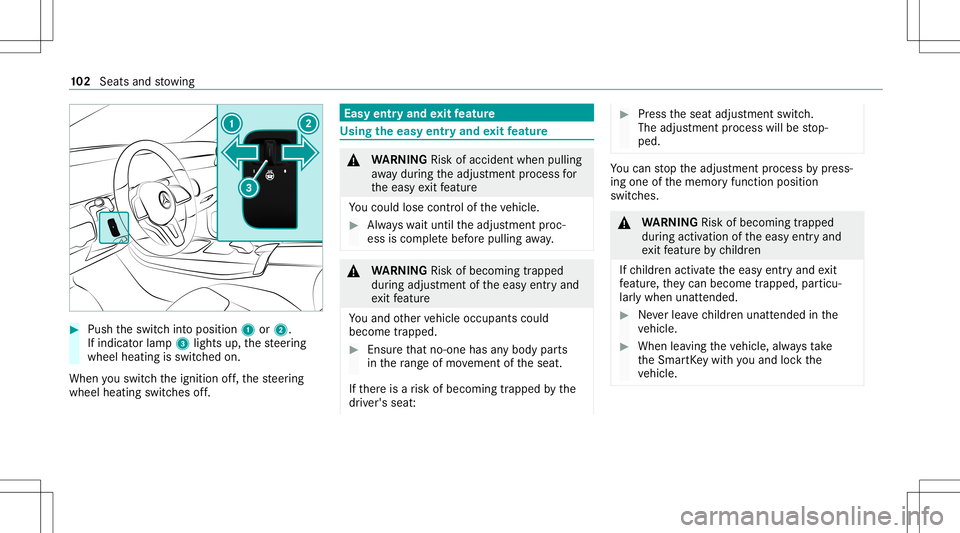
#
Push theswitc hint oposition 1or2.
If indicat orlam p3 lights up,thesteer ing
wheel heating isswitc hedon.
When youswit chtheignition off,th esteer ing
wheel heating switchesoff. Easy
entryand exitfeatur e Usi
ngtheeasy entryand exitfeatur e &
WARNIN GRisk ofacci dent whenpu lling
aw ay dur ing theadjus tmentpr ocess for
th eeasy exitfeatur e
Yo uco uld lose contro lof theve hicle. #
Alw ayswa itunt ilth eadjus tmentpr oc‐
ess iscom pletebef orepulling away. &
WARNIN GRisk ofbeco ming trap ped
du ring adjus tment oftheeasy entryand
ex itfeatur e
Yo uand other vehicle occupants could
become trapped. #
Ensur eth at no-one has anybody parts
in thera ng eof mo vement oftheseat.
If th er eis arisk ofbecoming trapped bythe
dr iver's seat: #
Press theseat adjus tmentswitc h.
The adjus tmentpr ocess willbestop‐
ped. Yo
ucan stop theadjus tmentpr ocess bypress‐
ing one ofthememor yfunc tion position
switc hes. &
WARNIN GRisk ofbeco ming trap ped
du ring acti vatio nof theeasy entryand
ex itfeatur eby childr en
If ch ildr enact ivat eth eeasy entryand exit
fe atur e,they can beco metrap ped ,pa rticu‐
lar lywhen unattende d. #
Neverlea vechildr enunat tende din the
ve hicle. #
When leaving theve hicle, alwaysta ke
th eSmar tKey wit hyo uand lockth e
ve hicle. 10
2
Sea tsand stow ing
Page 130 of 446

Cor
nering light Cor
nering light function The
corner ing light improve sth eillumination of
th ero ad ove ra wid eang lein thetur ning direc‐
tion ,enabling better visibility ontight curves, for
ex am ple. Itcan beact ivat ed onlywhen thelow
beam isswitc hedon.
The func tion isactiv ein thefo llo wing cases :
R Atspeeds below25 mph(4 0km/h) when
th etur nsignal lightisswitc hedonorthe
st eer ing wheel istur ned R
Atspeeds between 25mph(40 km/h) and
43 mph(70 km/h) andwhen thesteer ing
wheel istur ned
Ro undabout andintersec tion functi on:the
cor ner ing light willbe acti vatedon both sides
based onanevaluatio nof theve hicle's current
GP Spo sitio n.Itwi llre main activeuntil afte rth e
ve hicle hasleftth ero und about ortheint ersec‐
tion . Ad
aptiv eHighb eamAssist Ad
aptiv eHighb eamAssistfuncti on &
WARNIN GRisk ofacci dent despite
Ad aptiveHig hbeam Assis t
Ad aptiveHig hbeam Assis tdoes notre act to:
R Road user swit hout lights,e.g .pedes ‐
tr ians
R Road user swit hpoor lighting,e.g .
cy clis ts
R Road user swhos elight ingisobs truct ed,
e.g .by abar rier On
very rare occasions, AdaptiveHig hbeam
As sis tma yfa ilto recogni zeother road user s
wit hth eir ownlighti ng,orma yre cogni ze
th em toolat e.
In these, orinsimilar situation s,theaut o‐
matic highbeam willnotbe deactiv ated or
will beactiv ated despit eth epr esenc eof
ot her road user s. #
Alw aysobser vethero ad and traffic
condi tions carefu llyand switchof fth e
high beam ingood time. Ad
aptiveHig hbeam Assis tcan notta ke into
acc ount road, weather ortraf fic condi tions.
De tection maybe restrict ed inthefo llo wing
cases :
R Inpoor visibilit y,e.g. fog, hea vyrain or sno w
R Ifth er eis dir ton thesensor sor thesensor s
ar eobscur ed
Ad aptiveHig hbeam Assis tis on lyan aid. Youar e
re sponsible foradju sting theve hicle's lighting to
th epr eva iling light,visibilit yand traffic condi ‐
tions . 12
8
Light andvisib ility